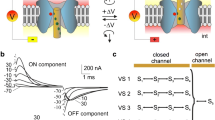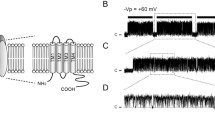Abstract
Using the patch-voltage clamp technique and the rescaled range method, activity of single large conductance Ca2+-activated K+ channels (KCa channels) was studied. For the sequences of alternating open and shut time intervals, the dependence R/S vs. Nτ in the double logarithmic coordinates presented a curve with two slopes, H1 =0.60 ± 0.04, and H2 = 0.88 ± 0.21, where H1 and H2 characterized the Hurst exponents for shot and long time ranges, respectively. Similar results were obtained for reduced data sets consisting of only open or only shut intervals. Randomization of the experimental data resulted in a single slope, H, of 0.52 ± 0.02. Simulations were performed with eight-state Markovian model without memory. The calculated Hurst exponent presented in average 0.54 ± 0.02. The results suggest that the activity of single Ca2+-activated K+ channel exhibits two regimes, with slight positive correlation at short time ranges (H1 =0.6), and strong positive correlation at long time ranges (H2 = 0.88); therefore the channel gating as a whole is not a steady-state Markovian process.
Similar content being viewed by others
References
McManus, O.B. and Magleby, L.K.: Kinetic time constants independent of previous single-channel activity suggest Markov gating for a large conductance Ca2+-activated K+ channel, J. Gen. Physiol. 64 (1989), 1037–1070.
Rothberg, B.S., Bello, R.A. and Magleby, K.L.: Two-dimensional components and hidden dependencies provide insight into ion channel gating mechanisms, Biophys. J. 72 (1997), 2524–2544.
Liebovitch, L.S. and Toth, I.: A model ion channel kinetics using deterministic chaotic rather than stochastic processes, J. Theor. Biol. 148 (1991), 243–267.
McManus, O.B., Blatz, A.L. and Magleby, K.L.: Inverse relationship of the durations of adjacent open and shut intervals for Cl and K channels, Nature 317 (1985), 625–627.
McManus, O.B., Weiss, D.S., Spivak, C.E., Blatz, A.L. and Magleby, K.L.: Fractal models are inadequate for the kinetics of four different ion channels, Biophys. J. 54 (1988), 859–870.
Liebovitch, L.S. and Sullivan, J.M.: Fractal analysis of a voltage-dependent potassium channel from cultured mouse hippocampal neurons, Biophys. J. 52 (1987), 979–988.
Geletyuk, V.I., Kazachenko, V.N. and Tseeb, V.E.: Quantized kinetic parameters of single ion channels, Dokl. Acad. Nauk USSR 301 (1988), 465–469.
Nogueira, R.A., Varanda, W.A. and Liebovitch, L.S.: Hurst analysis in the study of ion channel kinetics, Brasilian J. Med. Biol. Res. 28 (1995), 491–496.
Liebovitch, L.S. and Toth, T.I.: Fractal activity in cell membrane ion channels, Ann. N.Y. Acad. Sci. 591 (1990a), 375–391.
Liebovitch, L.S. and Toth, T.I.: Using fractals to understand the opening and closing of ion channels, Ann. Biomed. Engr. 18 (1990b), 177–194.
Hurst, H.E.: Long-term storage-capacity of reservoirs, Trans. Am. Soc. Civ. Engs. 116 (1951), 770–808.
Bassingthwaighte, J.B. and Raymond, G.M.: Evaluating rescaled range analysis for time series, Ann. Biomed. Eng. 22 (1994), 432–444.
Feller, W.: The asymptotic distribution of the range of sums of independent random variables, Ann. Math. Statistics 22 (1951), 427–432.
Teich, M.C., Heneghan, C., Lowen, S.B., Osaki, T. and Kaplan, E.: Fractal character of the neural spike train in the visual system of the cat, J. Opt. Soc. Am. A 14 (1997), 3529–3546.
Churilla, A.M., Gottschalke, W.A., Liebovitch, L.S., Selector, L.Y., Todorov, A.T. and Yeandle, S.: Membrane potential fluctuations of human T-lymphocytes have fractal characteristics of fractional Brownian motion, Ann. Biome. Eng. 24 (1996), 99–108.
Kazachenko, V.N., Geletyuk, V.I., Chemeris, N.K. and Fesenko, E.E.: Single Ca2+-activated K+ channels in cultured kidney cells Vero, Biophysics 41 (1996), 1359–1370.
McManus, O.B. and Magleby, K.L.: Kinetic states and modes of single large-conductance calcium-activated potassium channels in cultured rat skeletal muscle, J. Physiol. 402 (1988), 79–120.
McManus, O.B. and Magleby, K.L.: Accounting for the Ca2+-dependent kinetics of single large-conductance Ca2+-activated K+ channels in rat skeletal muscle, J. Physiol. 443 (1991), 739–777.
Clay, J.R. and DeFelice, L.J.: The relationship between membrane excitability and single channel open-close kinetics, Biophys. J. 42 (1983), 151–157.
Feder, J.: Fractals, Plenum Press, N.Y., 1988.
Author information
Authors and Affiliations
Rights and permissions
About this article
Cite this article
Kochetkov, K., Kazachenko, V., Aslanidi, O. et al. Non-Markovian Gating of Ca2+-Activated K+ Channels in Cultured Kidney Cells Vero. Rescaled Range Analysis. Journal of Biological Physics 25, 211–222 (1999). https://doi.org/10.1023/A:1005167101298
Issue Date:
DOI: https://doi.org/10.1023/A:1005167101298




